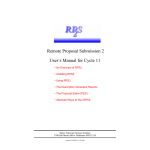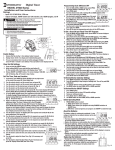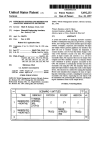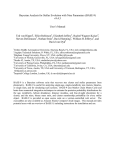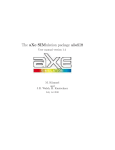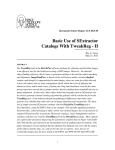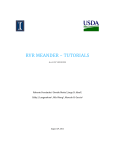Download A Tool for Astrophysical Data Analysis user manual
Transcript
TA-DA A Tool for Astrophysical Data Analysis version 0.98 user manual Nicola Da Rio [email protected] August 8, 2012 TA-DA was developed thanks to funding from the NASA Award Number NNX07AT37G Chapter 1 Introduction 1.1 What is TA-DA TA-DA is a powerful, integrated tool for the analysis of stellar photometric data, aimed to significantly simplify the process of comparing stellar photometric data with theoretical models. In the released version TA-DA allows to easily and reliably operate on synthetic photometry, creating theoretical spectral energy distributions (SEDs). The tool also supports analysis of photometry from different archives, SED model fitting, self-consistent prediction of stellar parameters based on multi-band photometry. TA-DA includes a comprehensive and updatable repository of throughputs of astronomical instruments and filters, stellar and synthetic spectra, and evolutionary models. Photometric and spectroscopic data can easily be imported from the Virtual Observatory as well as from user’s own tables and models. Results are produced in tabular or graphic format, readily usable for publication. TA-DA runs as an IDL widget application publicly available for download. 1.2 TA-DA functionalities We summarize here the main functionalities of TA-DA: 1. Computation synthetic photometry of complete grids of evolutionary models, or part of them, or any arbitrary set of stellar parameters. Observed fluxes or magnitudes and colors are computed in a number of units. Dust extinction can be considered in the computation. 2. The results of synthetic photometry are plotted for visual inspection, and can be saved to file. 1 2 3. Tables with observed photometry can be imported in the program. The individual entries in the imported table can be sorted and selected. The data are plotted in comparison with the synthetic photometry. 4. A universal fitting algorithm is used to derive the best stellar parameters of individual sources, based on the their magnitudes or colors, and associated photometric errors, in an arbitrary number of simultaneous bands (up to 16). 1.3 Installation The program is available as a pre-compiled IDL application. TA-DA can be obtained from the following URL: http://www.rssd.esa.int/SA-general/Projects/Staff/ndario/TADA/index.html as a compressed archive tada.zip. The archive content is the following: • the file tada.sav: the pre-compiled IDL code. • the directory tada data/: contains the necessary data for the program to run; e.g., the synthetic spectra, the filter profiles, some family of theoretical isochrones. • the directory example input files/: contains examples of input files that can be imported to data for testing. To install TA-DA it is sufficient to decompress the archive, and run the program tada.sav from IDL: IDL> cd,’/path/where/tada/is/located/’ IDL> tada Note: the user may consider adding the directory where the program is located is added to the IDL path, although this is not necessary. When TA-DA is started, it creates a widget-based interface. This is divided in 4 tabs, one for each main step of the analysis performed by the software: 1) The interpolation of evolutionary models; 2) the synthetic photometry, 3) the results of synthetic photometry, the plotting, and the uploading of the photometric data, and 4) the fitter engine. 3 1.4 Compatibility TA-DA has been developed to work under IDL version 7.0 or higher, on all Windows, Linux, or Mac OS platforms. The widget-based graphical user interface, however, looks and behaves best under Windows systems. This is because IDL widgets allow more strict positioning and sizes under Windows. 4 Chapter 2 Using TA-DA 2.1 Panel 1 - Physical stellar parameters for the model The first panel is dedicated to the preparation of the model stellar parameters for synthetic photometry. TA-DA allows two general approaches for this step, which can be switched from the top row of Panel 1 (see also Figure 2.1): 1. Evolutionary models: this approach considers evolutionary models (evolutionary tracks and isochrones). In this way the stellar parameters include, besides the effective temperature Teff , the stellar radius R, and the surface gravity log g (parameters necessary for synthetic photometry), also stellar masses M and stellar ages. 2. Arbitrary: this approach considers only the minimum parameters to perform synthetic photometry, i.e., Teff , R and log g. Stellar masses and ages, which are model dependent quantities, will be undefined. 2.1.1 Evolutionary models When selecting the evolutionary model approach, the panel shows additional widgets (see, e.g., Figures 2.1 and 2.2) where the parameters must be specified. Specifically, the user selects the family of evolutionary models; the available models are loaded automatically by TA-DA at startup, and additional families can be added (see the appendix for details). The user can then select among 5 options: (a) all isochrones: TA-DA considers all isochrones from the selected family of models. 5 6 Figure 2.1: Selection of the evolutionary models to use for synthetic photometry. (b) one isochrones: The user specifies one value of age, in Myr. TA-DA interpolates the evolutionary models to that value of age, if within the parameter range spanned by the models. (c) all tracks: TA-DA considers all mass tracks from the selected family of models. (d) one track: The user specifies one value of mass, in solar masses. TA-DA interpolates the evolutionary models to that value of mass, if within the parameter range spanned by the models. (e) manual input: Selecting this option the user specifies an arbitrary set of stellar parameters; this is passed to the software through an ASCII text file, selected through a popup window. The ASCII file must contain 2 columns (or more, in which case only the two are considered) which contain any combination of the following parameters: (a) mass (M ) (b) age (Myr) (c) log Teff (K) (d) log Lbol (L ) (e) R (R ) 7 The type of parameter described in each column must be manually specified through 2 drop lists in the widget GUI. The remaining 3 parameters (as well as the surface gravity log g) are interpolated by the TA-DA from the considered evolutionary models. TA-DA also checks that the user provided parameter grid lies inside the parameter space covered by the evolutionary models. If this condition is not matched for a fraction of the points, an warning message is generated, and the software neglects these points. If all the specified points lie outside the evolutionary model grid, an error is generated and the user is asked to modify the input parameters. Finally, the user must specify wether the parameters provided through the ASCII file represent a 1-dimensional curve, or a 2-dimensional grid. In the latter case, the grid must be rectilinear in the 2 parameters listed in the ASCII table, i.e. a “cartesian grid” with arbitrary spacing between lines and columns, no “holes”, and not necessarily complete at the edges. In Figure 2.3 some examples of allowed and not allowed configurations are shown for clarity. The distinction between a 1 or 2-dimensional inputs is relevant only when one runs the fitter within TA-DA, and is irrelevant for the computation of the synthetic photometry. In particular, if the parameters represent a 2D grid, the fitter will interpolate over the grid until the solution is found. The options a) and c) are very similar, since they both load the entire parameter space covered by the models. Nevertheless, there are two main differences between them: First, the option “all isochrones” has a finer sampling in masses, whereas “all tracks” has a finer sampling in ages. Therefore, if the ultimate goal of the user is a precise estimate of stellar masses, selecting “all isochrones” is more appropriate, and viceversa. Second, when plotting the result of synthetic photometry, TA-DA will plot individual isochrones or tracks according to the choice done here. 2.1.2 No evolutionary models, defining only Teff , log g, R TA-DA also allows to specify a more general set of stellar parameters which is independent on stellar evolutionary models. This method is activated selecting ”Arbitrary” option on the upperright part of the first panel. In this case (see Figure 2.4), the user must provide a 3-column ASCII table containing (in this order), values of Teff (in K), log g (in cgs units) and stellar radii R (in units of R ). These 3 parameters are sufficient to perform synthetic photometry (see Section 2) and compute absolute magnitudes (or fluxes); however, stellar masses and ages will not be defined. Note: unlike magnitudes, stellar colors are independent on luminosity, therefore on stellar radius. If user aims only at the analysis of stellar colors, the values of stellar radii specified in 8 Figure 2.2: Importing an arbitrary table of 2 stellar parameters. OK parameter 1 parameter 1 parameter 1 NO parameter 2 NO parameter 2 parameter 2 NO parameter 1 OK parameter 2 parameter 2 parameter 2 OK parameter 1 parameter 1 Figure 2.3: Examples of allowed (top row ) and not allowed (bottom row ) configurations for a user supplied 2-dimensional grid of stellar parameters. 9 Figure 2.4: Importing a set of values of Teff , gravity and stellar radius. the 3rd column of the ASCII file can be arbitrary, for example 1 R for every model point. In the first panel, clicking on the ”Submit” button will lock in the input parameters. TA-DA organizes the set of stellar parameters, perform any interpolation if needed, checks the validity of the model points, and moves to the next panel. Panel 2 - Synthetic Photometry In the second panel of TA-DA the user can define all the necessary ingredients to perform synthetic photometry on the previously defined grid of grid of stellar models. An example of the layout of this panel is shown in Figure 2.5. • Selection of the synthetic model grid: a drop-down menu lists the available grids of synthetic spectra. These are contained as fits table files in the subdirectory tada data/spectra/ within the TA-DA installation directory. When TA-DA is launched, the content of this directory is explored and the information on each data-cube of spectra is read. Thus, the user can add additional grids of atmosphere models, besides the defauld ones, provided that they are saved in the proper format and copied in the appropriate directory. Each grid can contain stellar spectra as a function of 3 parameters. The first two are Teff and log g; the third can be an arbitrary additional quantity, such as metallicity or any arbitrary parameter. The information on this parameter, as well as its range, are stored in the header 10 Figure 2.5: TA-DA second panel: input parameters for the synthetic photometry. of the fits table and automatically considered by TA-DA. For additional instructions on the format of the synthetic spectra cubes, see the appendix at the end of this manual. • Extrapolation of log g: this option allows the user to choose how TA-DA should consider model points with a surface gravity log g outside the parameter range convered by the selected grid of atmosphere models. If the option is deactivated, any point of the stellar parameters defined in panel 1 with a log g value outside the range spanned by the spectra (for the Teff of that point) is neglected in the computation of the synthetic photometry. If the option is activated, magnitudes and colors of parameter points with a log g out of range are extrapolated from synthetic photometry within the covered log g range. This extrapolation is useful when some model points correspond to log g values located just outside the grid. An example of such scenario is when the spectra from the AMES grid of Allard et al. (2000), defined for log g > 3.5, is selected together with PMS evolutionary models, which predict log g > 3.2 for the youngest ages in the very-low mass range. Since in general the computed magnitudes and colors depend only weakly on log g, extrapolating the results to a small extent outside of the grid, still provides acceptable results. The users should however be careful in selecting this option, making sure they are aware of the parameter space covered by their stellar parameters and the grid of spectra. 11 • Dust extinction: extinction can be added directly to the synthetic spectra before the computation of the synthetic colors and magnitudes. TA-DA currently includes the Galactic Cardelli (1989) extinction law, as well as the the reddening curves for the Magellanic Clouds from Gordon et al. (2003, LMC average, LMC2 supershell, SMC bar). The user specifies one or more values of V-band extinctions AV , and one or more values of the relative extinction parameter RV (only if the Cardelli reddening law is selected). Synthetic photometry will be performed separately for each of these n(AV ) × n(RV ) values on every stellar parameter point provided in Panel 1. If the user wants to leave reddening as a free parameter to be fit to the observational data (last panel of TA-DA widget GUI, see next sections), it is mandatory to indicate at least 2 distinct values of AV (e.g., 0 and 1) in this field. • Distance modulus: a unique value for the distance modulus (in magnitudes) to be applied to the computed magnitudes or fluxes must be specified in this field. • Photometric bands: the user specifies multiple (up to 16) photometric bands in which synthetic photometry has to be computed. These can be selected through drop-down menus, separately for the instrument (or photometric system) and the filter. The filter throughputs are stored as individual files in a TA-DA installation subdirectory ’/tada data/throughputs/’. The convention for the filenames is instrument filter.dat, and they contain a 2-column ascii indicating wavelength (in Å) and throughput (arbitrary relative units). TA-DA scans the content of this directory at start, so additional photometric systems or bands can be added by simply placing the relative files describing the filters profile in the appropriate directory. See the appendix for further details. By clicking the ”submit” button, the synthetic photometry code is started according to the selected parameters and options. Particularly large sets of model points may require some time (e.g. a full set of stellar masses and ages counting 100,000 model points, for 6 values of reddening and 6 photometric bands requires about 15 minutes of computing time on an average desktop computer). During the computation, the approximate progress (in percentage) is shown. Panel 3 - Results of synthetic photometry and plots After the synthetic photometry is computed, the software moves to the third panel (see Figure 2.6). Here a brief summary of the results is present. The synthetic photometry is natively 12 Figure 2.6: TA-DA panel with the results of synthetic photometry and plotting window. The small window on the top right corner is the model point information generated by right-clicking on a point of the plot (see below) 13 computed in units of VegaMag magnitudes, calibrated using a flux-calibrated spectrum of Vega (Bohlin et al 2007). However, the program derives all the conversions to express the results in units of ABmag or STmag magnitudes, as well as flux (either Jansky or erg/s/cm2 /Å). In the third panel it is possible to switch from one to another units. The results of synthetic photometry, in the chosen units, can be saved to a file through an apposite button. This will be an ASCII table, in which every row represents one model point. The columns report all the stellar physical parameters, as well as AV and the magnitudes (or fluxes). From panel 3 (with the button “Save filters information to file”)the saves a file with the information about the selected photometric bands. This includes effective wavelength, central wavelength, equivalent width, and the zero points in Jansky and erg/s/cm2 /Å. Such information may be useful when new filters are added providing solely the filter throughputs. At the completion of the synthetic photometry computation, TA-DA also creates a plotting window showing the results (see Figure 2.6). One can select the quantities shown in the two axes, choosing either colors or magnitudes, and arbitrary ranges for each axis. The units for each axis in the plot are automatically updated when the user changes the defaults units in Panel 3. If the selected units represent a flux (i.e., Jansky or rg/s/cm2 /Å), the color terms will be the ratio (instead of the difference) between the fluxes in the 2 selected filters. Panel 3 - Attaching photometric data From the right hand part of panel 3, the user can attach a table containing observational data to TA-DA. This is expected to contain multiple rows, one for each star, and multiple columns, providing photometry or additional data relative to each source. This generates a new widget window, showing the content of the table as well as a number of widgets to explore and organize its content, select individual sources, etc. Supported formats are either ASCII table or XML VOtable. The format, as well as the number columns and rows of the attached table are automatically detected by TA-DA. Figure 2.7 and 2.8 show two examples of the result, respectively for an ASCII and a VOTable. If the attached table is a VOtable, the original names of the fields (columns) are shown. In any case, the user must specify manually, through a drop-down menu for individual columns, if a particular column reports the observed photometry (or the associated photometric errors) in one of the bands for which synthetic photometry is computed. The software assumes the units are the same selected in Panel 3 of the main TA-DA window. The user table window also allows one to navigate through the table, sort columns and select individual rows (stars) for further 14 analysis. The selection can be performed manually, by clicking to the left side of each row, or automatically, by selecting all the rows, or the first n-rows in a given page or the entire table, or through and IDL logical expression. En example of such expression could be the following: johnson v ge 10 and err cousins i lt 1 and col9 ne ’new’ meaning that the software will select all the rows for which the Johnson V magnitude is greater or equal than 10 mag, the photometric error associated to the Cousins I photometry is less than 1 mag and the 9th column, not associated any photometric band, is not equal to the string ”new”. Note: the automatic selections at the bottom of the table window (selection by rows and by logical expression) are additive: stars that satisfy the input conditions are added to those previously selected. If you want to select only the stars that satisfy the last condition, you must deselect all the stars first, using the apposite button. Note: unlike magnitudes, stellar colors are independent on luminosity, therefore on stellar radius. If user aims only at the analysis of stellar colors, the values of stellar radii specified in the 3rd column of the ASCII file can be arbitrary, for example 1 R for every model point. When the user defines which column is associated to any photometric band previously used for performing synthetic photometry, and some stars (rows) are selected in the table window, the plot window is automatically updated showing, together with the computed models, the observed photometry of the selected stars. An example of this is shown in Figure 8: in this example the plot window shows a 2 color diagram computed in the bands (WFI V, WFI I and WFI Ti620), and the attached table provides photometry in these (and other) bands obtained in the Orion Nebula Cluster (Da Rio et al 2009). The models, indicate with different colors, represent the synthetic photometry in these bands for different Palla & Stahler isochrones. When at least 2 photometric bands are specified in the table window, and at least one star is selected, in the TA-DA main window the button ”go to the fitter” is activated. Clicking on this button produces a fourth panel in the TA-DA main window, with a list of options to perform the fit of the models on the attached data. Clicking on the plot window A mouse click on the plot window provides information on both stars and model points located in that point of the plot. • A left click is for the closest selected star to the clicked point: a popup windows is created showing the stars’ photometry, and the location of this star in the uploaded table. 15 Figure 2.7: Example of ASCII table imported to the TADA. • A right click is for the closest model point to the clicked point: a popup windows is created showing the parameters associated to that point (e.g., mass, age, log Teff , log L, stellar radius, log g, as well as the value of the quantities plotted in the two axes (e.g., color and magnitude). Clearly, whereas the right click will in general always work (results of synthetic photometry always appear in the plot), the left click will work only if a table with the observed photometry is attached, the two quantities plotted are specified, and at least one star is selected from the table panel. Adding labels to the plot By default, the plot window shows a label, located in the top left corner, reporting the name of the used evolutionary models and synthetic spectra. It is possible to customize the label, remove it, displace it, or change the information reported. This can be done by editing the file tada data/tadaplot additional instructions.dat within the TA-DA installation directory, where the actual IDL code lines which produce the label are declared. Further explanations on how to do this, as well as additional examples, are present in the file itself. 16 Figure 2.8: Example of user data table attached to TA-DA, originally in format of VOTable. Figure 2.9: Example of the plotting window, showing both TADA computed models and the user photometry. 17 Panel 4 - The stellar parameter fitter The photometry fitter included in TA-DA allows one to derive the stellar parameters of the individual stars selected in the attached table. This is a universal fitter and can be used in different scenarios, based on the type of models on which synthetic photometry is performed, the number of photometric bands of the measured photometry, and the options declared in the fitter panel. In general, we distinguish two cases: 1. Interpolation of evolutionary models (and extinction): if the number of free parameters is equal to the dimension of the measured photometry space, an exact solution can be obtained (potentially) of each source. Some examples are: (a) Interpolation in the CMD: the synthetic photometry is computed for a number of isochrones or tracks, the data include 2 photometric bands, and the extinction is a fixed parameter: the software will assign age and mass to the individual sources. (b) Dereddening onto one isochrone: the synthetic photometry is computed for a single isochrones, 2 observed magnitudes or colors are provided, the extinction is a free parameter: the software will determine the amount of reddening and the de-reddened position along the isochrone for each star. (c) Determination of 2 stellar parameters (e.g., mass and age, or Teff and log L) as well as extinction, for each star, based on 3 magnitudes or 3 colors. 2. Probabilistic (SED) fitting: if the number of measured magnitudes or colors exceeds that of the free parameters, the best fit solution for the parameters of each star is provided. This approach is analogous to a general spectral energy distribution (SED) fitting procedure, in which extinction can be either constrained of left as a free parameter, and the user can decide whether to consider only the shape of the SED, or also the actual luminosity (fitting photometric colors or photometric magnitudes). Figure 9 shows an example of the fitter panel. From the top of the panel, the user selects which photometric bands to use for estimating the stellar parameters. The available bands are those for which synthetic photometry was previously computed. The user should keep in mind to select only bands for which the observed magnitudes or fluxes are provided, and declated in the table window. Clearly, at least 2 bands must be selected. Next, the user can specify if the fit should be performed on the magnitudes (in a n-dimensional magnitude space) or on the colors (in a n-1 dimensional color space). The latter option is useful 18 when the particular astrophysical problem the user is interested to solve requires the assessment of the stellar parameters in a luminosity (or distance) independent way. If the uploaded photometry table includes also columns reporting the photometric errors in each band, it is possible to select weather the software should consider these errors in the fit or to neglect photometric errors and treat the photometry as a individual points for each star. Practically, not considering the photometric errors corresponds to assigning a constant identical error to every magnitude or color. If the photometric errors are used, a further options allows to activated a Monte Carlo (MC) simulation to derive the errors in each derived stellar parameter for the individual sources. This step is quite time consuming; however it is needed to allow for a reliable estimate of the uncertainties, since, in general, the measured photometric errors lead to highly correlated and non-linear errors in the model parameter space. Finally the user can select whether to fix a single value of AV for every star, or to leave the reddening as a free parameter, to be derived by the fitter star by star. In this latter case, a range of extinction values and a first order resolution is specified. Important note: in order to leave reddening as a free parameters, at least 2 distinct values of AV must have been specified earlier when the synthetic photometry was performed (Panel 2). By clicking on the button ”run fitter”, the parameter fitting algorithm processes each selected star of the user data table. Data outside the model predicted space In both the cases introduced above (interpolation and exact solution, or probabilistic approach), it is possible that stars show observed magnitude or colors which are incompatible with the predictions from the synthetic photometry on the evolutionary models. As an example, one could consider a star located just below the main sequence on a CMD. In these cases, TADA still provides the most probable solution, which is the closest point to the observed fluxes and within the theoretical magnitude space in the direction of the photometric errors. This is illustrated in Figure 2.11. Along with the estimated parameters for each source, the results of the fitter provide the distance, in units of photometric error sigma, from the observed fluxes to the those of the most probable solution. The user can then use these values to discern among solutions to be kept or rejected. Although this applies to both the case of interpolation of parameters and SED fitting, there is a significant conceptual difference between these two cases: 19 • in the interpolation case (number of free parameters = number of fitted observed quantities), if a star is located within the modeled grid, an exact solution is always found (χ2 = 0). Thus the fitter precisely distinguish between points inside or outside the grid, flags sources accordingly, and use the correct method to provide the best-fit parameters. Figure 10 schematizes the process for the two sub-cases a) and b), for a 2 dimensional magnitude space. • in the actual SED fitting case (number of free parameters ¡ number of fitted observed quantities) an exact solution (χ2 = 0) is generally never found. Thus, TA-DA arbitrarily considers stars to be incompatible with the model grid when they lie at > 3σ from the edge of the grid. In any case, the results of the fitter include, for every star, two parameters that are useful to understand the goodness of the fit: 1. “exact”: is 1 if the observed star lies inside the parameter space covered by the model, 0 otherwise (see above) 2. “distance in sigma”: reports the distance, in units of the overall photometric error, from the observed magnitude, colors, or fluxes of the star to the closest (best-fit) point of the model grid. The results of the fit can be saved to an ASCII table, either preserving the same row to row correspondence of the imported data table, or just limited to the selected source. 20 Figure 2.10: Example of the Parameters Fitter panel data point outside grid: most likely solution mag2 a b data point inside grid: exact solution + error range model mag1 Figure 2.11: Schematic representation of the best-parameter fitting technique: a probabilistic approach when the observed data are outside the range spanned by the models (a) and an exact interpolation otherwise (b) 21 Figure 2.12: Interface to save the fitting results. 22 Appendix Filter profiles The current version of TA-DA includes the following filter profiles, located in the folder tada data/throughputs/: 2MASS H 2MASS J 2MASS KS ACSHRC F220W ACSHRC F250W ACSHRC F330W ACSHRC F344N ACSHRC F435W ACSHRC F475W ACSHRC F502N ACSHRC F550M ACSHRC F555W ACSHRC F606W ACSHRC F625W ACSHRC F658N ACSHRC F660N ACSHRC F775W ACSHRC F814W ACSHRC F850LP ACSHRC F892N ACSSBC F115LP ACSSBC F122M ACSSBC F125LP ACSSBC F140LP ACSSBC F150LP ACSSBC F165LP ACSWFC F435W ACSWFC F475W ACSWFC F502N ACSWFC F550M ACSWFC F555W ACSWFC F606W ACSWFC F625W ACSWFC F658N ACSWFC F660N ACSWFC F775W ACSWFC F814W ACSWFC F850LP BESSELL B BESSELL BW BESSELL I BESSELL R BESSELL U BESSELL V CFHT H CFHT I CFHT J CFHT KS CFHT Y COUSINS I COUSINS R GALEX FUV GALEX NUV IRAC I1 IRAC I2 IRAC I3 IRAC I4 ISAAC F1215 ISAAC F1710 ISAAC F2090 ISAAC F3280 ISAAC FL BB JOHNSON B JOHNSON U JOHNSON V LANDOLT B2 LANDOLT B3 LANDOLT U LANDOLT V NICMOS F110W NICMOS F160W NICMOS F165M NICMOS F187W NICMOS F190N NICMOS F205W NICMOS F207M NICMOS F222M NIRCAM F070W NIRCAM F090W NIRCAM F115W NIRCAM F140M NIRCAM F150W NIRCAM F150W2 NIRCAM F162M NIRCAM F164N NIRCAM F182M NIRCAM F187N NIRCAM F200W NIRCAM F210M NIRCAM F212N NIRCAM F225N NIRCAM F250M NIRCAM F277W NIRCAM F300M NIRCAM F322W2 NIRCAM F323N NIRCAM F335M NIRCAM F356W NIRCAM F360M NIRCAM F405N NIRCAM F410M NIRCAM F418N NIRCAM F430M NIRCAM F444W NIRCAM F460M NIRCAM F466N NIRCAM F470N NIRCAM F480M SDSS G SDSS I SDSS R SDSS U SDSS Z STISCCD 50CCD STISCCD F28X50LP STISFUV 25MAMA STISFUV F25LYA STISFUV F25QTZ STISFUV F25SRF2 STISNUV 25MAMA STISNUV F25CIII STISNUV F25CN182 STISNUV F25CN270 STISNUV F25MGII STISNUV F25QTZ STISNUV F25SRF2 STROMGREN B STROMGREN OLD U STROMGREN U STROMGREN V STROMGREN Y TYCHO B TYCHO V WFC3IR F098M WFC3IR F105W WFC3IR F110W WFC3IR F125W WFC3IR F126N WFC3IR F127M WFC3IR F128N WFC3IR F130N WFC3IR F132N WFC3IR F139M WFC3IR F140W WFC3IR F153M WFC3IR F160W WFC3IR F164N WFC3IR F167N WFC3UVIS F200LP WFC3UVIS F218W WFC3UVIS WFC3UVIS WFC3UVIS WFC3UVIS WFC3UVIS WFC3UVIS WFC3UVIS WFC3UVIS WFC3UVIS WFC3UVIS WFC3UVIS WFC3UVIS WFC3UVIS WFC3UVIS WFC3UVIS WFC3UVIS WFC3UVIS WFC3UVIS WFC3UVIS WFC3UVIS WFC3UVIS WFC3UVIS WFC3UVIS WFC3UVIS WFC3UVIS WFC3UVIS WFC3UVIS WFC3UVIS WFC3UVIS WFC3UVIS WFC3UVIS WFC3UVIS WFC3UVIS WFC3UVIS WFC3UVIS WFC3UVIS WFC3UVIS WFC3UVIS WFC3UVIS WFC3UVIS WFC3UVIS WFC3UVIS WFC3UVIS WFC3UVIS WFC3UVIS WFC3UVIS WFC3UVIS WFC3UVIS WFC3UVIS WFC3UVIS F225W F275W F280N F300X F336W F343N F350LP F373N F390M F390W F395N F410M F438W F467M F469N F475W F475X F487N F502N F547M F555W F600LP F606W F621M F625W F631N F645N F656N F657N F658N F665N F673N F680N F689M F763M F775W F814W F845M F850LP F953N FQ232N FQ243N FQ378N FQ387N FQ422M FQ436N FQ437N FQ492N FQ508N FQ575N WFC3UVIS FQ619N WFC3UVIS FQ634N WFC3UVIS FQ672N WFC3UVIS FQ674N WFC3UVIS FQ727N WFC3UVIS FQ750N WFC3UVIS FQ889N WFC3UVIS FQ906N WFC3UVIS FQ924N WFC3UVIS FQ937N WFI 571 WFI 753 WFI 770 WFI 851 WFI 852 WFI 853 WFI 870 WFI B WFI B842 WFI FLAT WFI HA WFI I WFI I879 WFI TI620 WFI U WFI U841 WFI V WFPC2 F170W WFPC2 F255W WFPC2 F300W WFPC2 F336W WFPC2 F380W WFPC2 F439W WFPC2 F450W WFPC2 F467M WFPC2 F502N WFPC2 F547M WFPC2 F555W WFPC2 F569W WFPC2 F606W WFPC2 F631N WFPC2 F656N WFPC2 F673N WFPC2 F675W WFPC2 F702W WFPC2 F785LP WFPC2 F791W WFPC2 F814W WFPC2 F850LP WHITE WHITE To add new filters, it is sufficient to put a file containing its profile in the same directory. This 23 24 must be a 2-column ASCII file, with a name instrumentname bandname.dat. The first column is the wavelength in Angstrom, the second is the associated filter throughput. The scaling units of the throughputs are absolutely irrelevant (e.g., the peak could be 1 or not). In case of broad band filters, make sure that the profile you have includes also the other instrumental efficiencies, e.g., the transparency of the optics and most importantly the detector efficiency as a function of wavelength. If your filter has a VegaMag zeropoint (which is the magnitude of Vega in that filter) different than zero (which is the case for some old photometric systems), this value should be added in the file tada data/zeropoints.dat, following the format of the entries in the same file. Evolutionary models The present version of TA-DA includes already a number of evolutionary models namely: • for evolved population (e.g, globular clusters): – Marigo et al. (2008) models • for pre-main sequence populations: – Palla & Stahler (1999) models – Siess et al. (2000) models – Baraffe et al. (1998) models – D’Antona & Mazzitelli (1998) models – PISA/Franec models from Tognelli et al. (2011) These are located, as fits table files, in the directory tada data/isochrones/. The PISA/Franec grids include a large number of isochrones for several metallicities, mixing length parameter, helium abundance and deuterium abundance. For this reason, the original installation package of TA-DA (tada.zip, downloadable from the website) includes only the most used models for solar metalliticy. The rest of the grid can be downloaded, if needed, separately from the TA-DA website. To add new family of models, one must put a properly formatted file containing them in this directory. Specifically, this must be a fits table must contain 4 columns, in this order: 1. mass (in units of M ) 2. log age (in logarithm of years) 25 3. log Teff (in logarithm of K) 4. log Lbol (in L ) The header of the fits table must also include the following additional keywords: • NAME - the name of the family of models, e.g., “Siess (2000) oversh.” • SHORTNAM - a shorter (with no spaces) name, e.g., “siessover” • M/H - the metallicity [M/H], e.g, ’0.0’ (float) • MTYPE - the type of models, e.g, “PMS” (not used by TA-DA) • col1 - mass (content of the first column, not actually used by TA-DA, so please do not change the order of the four) • col2 - logage (content of the second column) • col3 - logt (content of the third column) • col4 - logl (content of the fourth column) Here we have an example of how to produce a valid format fits table from IDL. I will assume you have already 4 IDL variables named "mass", "logage", "logt", "logl" as one dimensional arrays of floating-point numbers containing this quantities. ;;;;;;;;;;;;;;;;;;;;;;;;;;;;;;;;;;;;;;;;;;;;;;;; fileout=’/your/path/girardi_models.fits’ FXHMAKE,hdr,/EXTEND FXWRITE,fileout,hdr FXBHMAKE,newhdr,1 FXBADDCOL,c1,newhdr,[[mass]] FXBADDCOL,c2,newhdr,[[logage]] FXBADDCOL,c3,newhdr,[[logt]] FXBADDCOL,c4,newhdr,[[logl]] FXADDPAR,newhdr,’NAME’,’Girardi et al. (2000)’ FXADDPAR,newhdr,’SHORTNAM’,’girardi’ FXADDPAR,newhdr,’MTYPE’,’postMS’ FXADDPAR,newhdr,’M/H’,0.0 FXADDPAR,newhdr,’col1’,’mass’ FXADDPAR,newhdr,’col2’,’logage’ FXADDPAR,newhdr,’col3’,’logt’ FXADDPAR,newhdr,’col4’,’logl’ FXBCREATE,unit,fileout,newhdr FXBWRITE,unit,mass,c1,1 26 FXBWRITE,unit,logage,c2,1 FXBWRITE,unit,logt,c3,1 FXBWRITE,unit,logl,c4,1 FXBFINISH,unit ;;;;;;;;;;;;;;;;;;;;;;;;;;;;;;;;;;;;;;;;;;;;;;;; Important note: the grid of evolutionary models must be already densely interpolated (with a resolution in the parameter space not much worse than the precision you aim to achieve in fitting your data with TA-DA), and rectilinear in mass and log age (see Figure 2.3 for what this means). Synthetic spectra The current version of TA-DA includes a number of grids of synthetic spectra, used to perform synthetic photometry. These are: • The BT-Settle grid of Allard et al. (2010), defined for 2000 K< Teff <70,000 K, -0.5< log g <5.5, -1< [M/H] <0.3 • The NextGen grid of Hauschildt et al. (1997), defined for 2500 K< Teff <50,000 K, 2< log g <5.5, -1.5< [M/H] <0 • The NextGen grid of Hauschildt et al. (1997) complemented with the AMES-MT grid of Allard et al. (2001) for the low Teff , defined for 2000 K< Teff <50,000 K, 3< log g <5.5, [M/H] = 0 • The AMES-Settle grid of Allard et al. (2002), defined for 1100 K< Teff <2300 K, 4.5< log g <5.5, -1< [M/H] <0 One can add additional grids, by placing them in a proper format in the same directory. The grid of spectra must include a spectrum as a function of 3 parameters: the first 2 must be Teff (in Kelvin) and log g (in logarithm of cm s−2 ); the third parameter is typically metallicity [M/H], but can be any other arbitrary quantity. The grids of spectra must be stored as a 5-column fits table, where the columns are: 1. wavelength - in Angstrom (1-dimensional, nlambda elements) 2. Tef f - in Kelvin (1-dimensional, nmodels elements) 3. log g - in log of cm s−2 (1-dimensional, nmodels elements) 27 4. third parameter - whatever units, e.g., metalliticy in [M/H] (1-dimensional, nmodels elements) 5. the actual spectra - in erg s−1 cm−2 Å−1 (2-dimensional, nmodels×nlambda elements) The fits tables must also include these additional keywords in their headers: NAME = ’Ames Settle 2002’ PARN = WAVN = /name of the grid 3 /number of model parameters 1221 /number of wavelength points WAVUNIT = ’Angstrom’ /units of wavelength scale PARNAME1= T /name of first parameter PARNAML1= ’Temperature’ /name of first parameter (long) PARUNIT1= ’K /units of first parameter ’ PARMIN1 = 1100.00 /minimum value of first parameter PARMAX1 = 2300.00 /maximum value of first parameter PARNAME2= ’logg ’ /name of second parameter PARNAML2= ’Surface gravity’ /name of second parameter (long) PARUNIT2= ’log(cgs)’ /units of second parameter PARMIN2 = 4.50000 /minimum value of second parameter PARMAX2 = PARNAME3= ’[M/H] 5.50000 /maximum value of second parameter ’ /name of third parameter PARNAML3= ’Metallicity’ /name of third parameter (long) PARUNIT3= ’log(ratio)’ /units of third parameter PARMIN3 = -1.00000 /minimum value of third parameter PARMAX3 = 0.000000 /maximum value of third parameter MODN = 52 /number of model spectra Here I present an example of IDL code to produce a model grid. It is assumed that the 5 variables lambda, teff, logg, metallicity and spectra are already stored in IDL as arrays: filename=’/your/path/synthetic_grid.fits’ FXHMAKE,hdr,/EXTEND FXWRITE,filename,hdr FXBHMAKE,newhdr,1 FXBADDCOL,c1,newhdr,[[lambda]] FXBADDCOL,c2,newhdr,[[teff]] FXBADDCOL,c3,newhdr,[[logg]] FXBADDCOL,c4,newhdr,[[metallicity]] FXBADDCOL,c5,newhdr,[[spectra]] FXADDPAR,newhdr,’NAME’,’The name of my grid’ FXADDPAR,newhdr,’MODTYPE’,’Star’ FXADDPAR,newhdr,’PARN’,3 FXADDPAR,newhdr,’WAVN’,(size(lambda))[1] FXADDPAR,newhdr,’WAVUNIT’,’Angstrom’ FXADDPAR,newhdr,’PARNAME1’,’T’ FXADDPAR,newhdr,’PARNAML1’,’Temperature’ FXADDPAR,newhdr,’PARUNIT1’,’K’ FXADDPAR,newhdr,’PARLOG1’,0 28 FXADDPAR,newhdr,’PARMIN1’,min(teff) FXADDPAR,newhdr,’PARMAX1’,max(teff) FXADDPAR,newhdr,’PARNAME2’,’logg’ FXADDPAR,newhdr,’PARNAML2’,’Surface gravity’ FXADDPAR,newhdr,’PARUNIT2’,’log(cgs)’ FXADDPAR,newhdr,’PARLOG2’,1 FXADDPAR,newhdr,’PARMIN2’,min(logg) FXADDPAR,newhdr,’PARMAX2’,max(logg) FXADDPAR,newhdr,’PARNAME3’,’[M/H]’ FXADDPAR,newhdr,’PARNAML3’,’Metallicity’ FXADDPAR,newhdr,’PARUNIT3’,’log(ratio)’ FXADDPAR,newhdr,’PARLOG3’,1 FXADDPAR,newhdr,’PARMIN3’,min(metallicity) FXADDPAR,newhdr,’PARMAX3’,max(metallicity) FXADDPAR,newhdr,’MODN’,(n_elements(teff)) FXBCREATE,unit,’filename,newhdr FXBWRITE,unit,lambda,c1,1 FXBWRITE,unit,teff,c2,1 FXBWRITE,unit,logg,c3,1 FXBWRITE,unit,metallicity,c4,1 FXBWRITE,unit,spectra,c5,1 FXBFINISH,unit Contents 1 Introduction . . . . . . . . . . . . . . . . . . . . . . . . . . . . . . . . . . . . . . . 1 1.1 What is TA-DA . . . . . . . . . . . . . . . . . . . . . . . . . . . . . . . . . . . . . 1 1.2 TA-DA functionalities . . . . . . . . . . . . . . . . . . . . . . . . . . . . . . . . . 1 1.3 Installation . . . . . . . . . . . . . . . . . . . . . . . . . . . . . . . . . . . . . . . 2 1.4 Compatibility . . . . . . . . . . . . . . . . . . . . . . . . . . . . . . . . . . . . . . 3 2 Using TA-DA . . . . . . . . . . . . . . . . . . . . . . . . . . . . . . . . . . . . . . 2.1 5 Panel 1 - Physical stellar parameters for the model . . . . . . . . . . . . . . . . . 5 2.1.1 Evolutionary models . . . . . . . . . . . . . . . . . . . . . . . . . . . . . . 5 2.1.2 No evolutionary models, defining only Teff , log g, R . . . . . . . . . . . . . 7 Panel 2 - Synthetic Photometry . . . . . . . . . . . . . . . . . . . . . . . . . . . . . . . 9 Panel 3 - Results of synthetic photometry and plots . . . . . . . . . . . . . . . . . . . 11 Panel 3 - Uploading photometric data . . . . . . . . . . . . . . . . . . . . . . . . . . . 13 Clicking on the plot window . . . . . . . . . . . . . . . . . . . . . . . . . . . . . . 14 Adding labels to the plot . . . . . . . . . . . . . . . . . . . . . . . . . . . . . . . 15 Panel 4 - The stellar parameter fitter . . . . . . . . . . . . . . . . . . . . . . . . . . . . 17 Models and Filters . . . . . . . . . . . . . . . . . . . . . . . . . . . . . . . . . . . . . 23 Filter profiles . . . . . . . . . . . . . . . . . . . . . . . . . . . . . . . . . . . . . . . . . 23 Evolutionary models . . . . . . . . . . . . . . . . . . . . . . . . . . . . . . . . . . . . . 24 Synthetic spectra . . . . . . . . . . . . . . . . . . . . . . . . . . . . . . . . . . . . . . . 26 29































